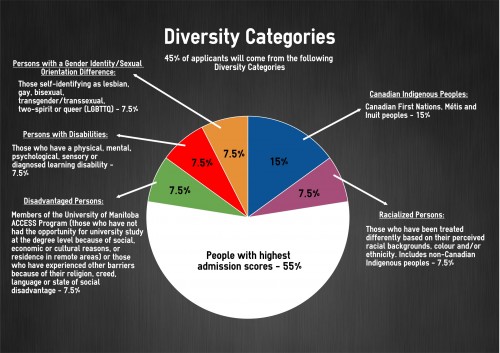The faculty of education at the University of Manitoba (U of M) approved a policy which will ensure a proportion of students entering its programs are from minority groups.
The policy, which will take effect in September 2017, will admit 45 per cent of applicants who self-identify under different categories of diversity, according to a U of M news release.
Students who qualify for the faculty’s diversity categories include those who classify themselves as a person with disabilities, Indigenous, racialized, lesbian, gay, bisexual, transgender (LGBTQ), or disadvantaged due to homelessness, low levels of education, or chronic low income.
Melanie Janzen, the associate dean of undergraduate programs, said the target groups included in the policy are reflective of protected categories under the province’s human rights code.
She said the faculty’s decision to incorporate more students from traditionally marginalized groups will provide a richer experience for both students and instructors.
“The policy makes a public statement about our commitment to diversity and equity,” Janzen said. “It says to folks who may not have previously seen themselves as teachers—perhaps because they didn’t see others like them in teaching roles—that they are welcome in our faculty.”
However Rodney Clifton, professor emeritus of education at U of M, said he is concerned about the proficiency of students admitted under the diversity categories.
He explained the faculty of education’s minimum entrance grade of C+ allows for a large variance in competency. He said this could result in the possibility that those categorized as disadvantaged who meet the requirements at a lower level could be favoured over those in the general admittance stream who meet requirements at a higher level.
According to Clifton, other faculties at the school accommodating for students of diversity have much higher minimum grade requirements, so there is less room for variability. He said for example, U of M’s engineering program requires both diverse and generalized students to have a minimum grade of 85 in their high school math marks.
“If the faculty gets labeled as having lower quality standards than other faculties, and if school divisions don’t hire the teachers . . . what does that mean for the whole program?” Clifton said.
He also said the faculty doesn’t have any current data on the different identities already present among students.
“Certainly, the diversity has been increasing over the last 15 or 20 years that I’ve been teaching there, so we may be up to that standard anyways,” Clifton explained.
Janzen said Clifton is correct the faculty doesn’t have current information on the breakdown of diversity among students. But she said she doesn’t agree with the argument that students who qualify under a diversity category could be less proficient, since it inadvertently holds racist undertones.
“What gets overlooked within a framing of ‘best scores’ is that it does not account for the ways in which all of our experiences are enhanced by a diversity of opinions, perspectives and understandings,” she explained.
Reece Malone is the education program coordinator for Rainbow Resource Centre, a Winnipeg organization which supports the LGBTQ community.
Malone said an increase in teachers from minorities can benefit society, as it ensures those who have traditionally been discriminated against are included.
“As more teachers directly or indirectly disclose their sexual orientation or gender identity, the more connected LGBTQ students may feel, and thus less isolated, marginalized and safer,” Malone explained.
He said recognizing diversity is part of the reality of living in a society that often disadvantages minority groups, and reflects Canada’s changing demographics.






